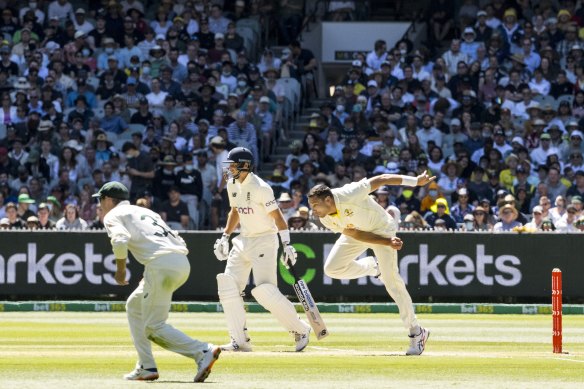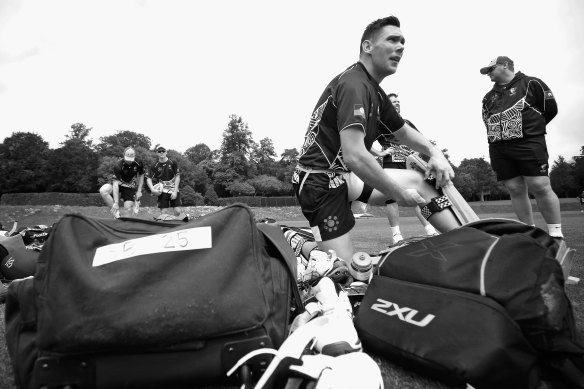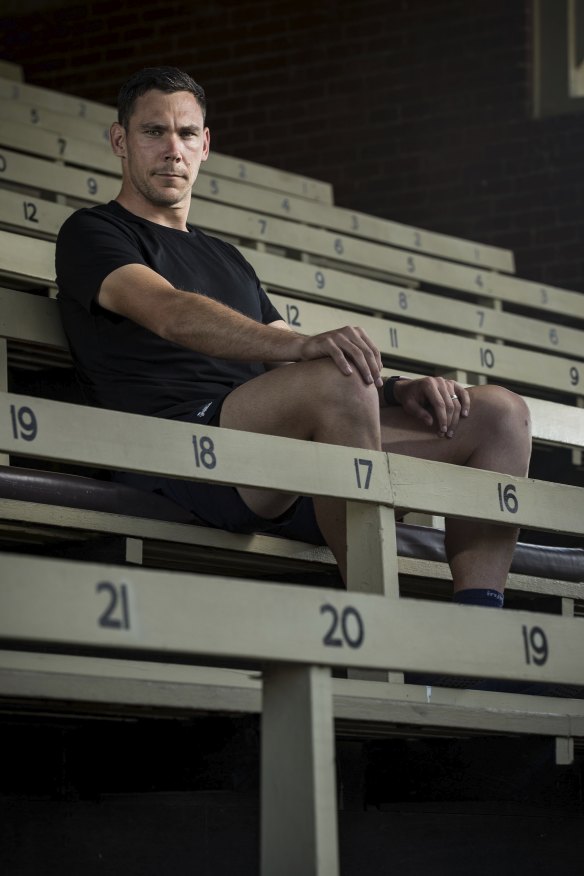Scott Boland isn’t an anonymous face at the ’G anymore
Scott Boland was used to disappearing in a crowd.
For almost the entirety of his Victoria career, he could live with the anonymity of a quality seam bowler in the Sheffield Shield, testing the techniques of Australia’s best batters while watched by a handful of loyalists.
Scott Boland in the midst of his 6-7 against England at the MCG.Credit:Chris Hopkins
The measure of his breakthrough moment, as Johnny Mullagh medallist and destroyer of England in an unforgettable Boxing Day debut Test, arrived on Boland’s next visit to a packed MCG – as a spectator for the round 11 battle between Collingwood and Carlton, in which the fast-finishing Blues tried and failed to overtake the Pies.
“I went to the footy with some mates to the ’G, I think there was 80,000 there, a great atmosphere,” Boland tells The Age and The Sydney Morning Herald ahead of his first Shield game of the season, against South Australia in Adelaide on Thursday.
“We actually thought it was done, went inside and then the crowd started erupting. We probably missed the best part of the game!
“But I was blown away by how many people recognised me and wanted to chat, take a photo and stuff like that. So, the support from people has been amazing. I’ve only ever heard good things come from people’s mouths, which has been great.”
That notoriety has a deeper significance for Boland than most other Australian players, of course. As an Aboriginal cricketer, Boland carries with him the spirit of the first XI of 1866-68, and the motivation to ensure that he and others like Ash Gardner, D’Arcy Short and Brendan Doggett are not the outliers of an Australian cricket story that has been overwhelmingly monocultural.
“I remember during the Welcome to Country and the national anthems that I got a special mention,” Boland says. “That was pretty cool, not something I expected to happen, and it got a huge cheer from the crowd, so that’s something I’ll always remember.
“If myself or Ash Gardner or D’Arcy Short or whoever it is, is doing really well on TV, hopefully more young Indigenous kids are going to pick up a bat and a ball and try to get involved in cricket.
“That’s a goal of all of us to try to make cricket a bit more mainstream in Aboriginal communities. I really want to help ensure that my success is really only a starting point for Aboriginal involvement in the game, not an end point.”
Scott Boland pads up in Sussex during the 2018 tour of England to mark the sesquicentenary of the Indigenous XI tour of 1868.Credit:Getty Images
Key to Boland’s story is 2018, when he learned of his Aboriginal heritage and lived it out on a visit to Mullagh’s home in Harrow and then a tour of England.
It was also the year that Boland’s first daughter was born, helping to provide him with a balanced view of life that married happily with a determination not to miss playing big games for Victoria – he was omitted from the 2016 Shield final team.
“We had that tour where me and my brother Nick got to go away to England and experience and learn about our family heritage and how big and how deep Aboriginal culture runs into cricket history,” he recalls.
“My first daughter was born in 2018 as well, so it was a pretty big year. Both of those things combined gave me a bit of a different outlook on cricket where probably in the past – I was four years younger as well – I definitely stressed the small things in cricket.
Scott Boland.Credit:Darrian Traynor
“Whereas now, I can come home and see the girls and I forget about cricket for the night, even if I’ve had a bad day or whatever. So, 2018 was a huge year and a life-changing one.”
In statistical terms, in 2018, Boland cut his average from 28 to 21 and strike rate from 60 to 47. Self-knowledge, he believes, extended to the mental and physical capacity to bowl unstinting spells of the kind that flummoxed England.
“Had I got picked four or five years earlier and whether I struggled in my first game or did well, I probably would’ve been searching for something extra, whereas now I’m pretty comfortable with my skills,” he says.
“I know my action inside out that if something is a little bit off I know how to pick it up pretty quickly, whereas five years ago, it probably took me an extra session or extra spell. That helps the team – I feel like I’m not bowling too many spells where I’m not threatening, I feel like I’m always on the mark.”
Boland’s method is simple, but more nuanced than it once was. Not interested in swinging the ball, he manipulates seam and bowling grip to find lateral and vertical variation – aligned to Steve Smith’s contention that a seaming ball is altogether more difficult to counter than a swinging one.
“I don’t try to swing the ball at all,” Boland says. ″There was probably a stage of my career where I bowled every ball with exactly the same grip, where now I change it up quite a lot.
“Then if I get to a point where I’m ‘Right, I need to find a way for the ball to do something’, I try a couple of different grips, I’ll split my fingers a bit wider, stuff like that. If I can find something that works I’ll stick with that for a little bit longer. But when the conditions are in the bowler’s favour, definitely seam bowling is a lot harder to face than swing bowling.”
This summer, Boland can rightly expect to play at least a couple of Test matches, pending the fitness and workloads of captain Pat Cummins, Josh Hazlewood and Mitchell Starc against the West Indies and South Africa.
Beyond that, and a tour of India where more time running drinks seems likely, there is a tour of England that will allow Boland to return to the scene of the 2018 tour that helped make him a Test cricketer in the first place.
There is something else Boland has had to get used to in addition to losing his former anonymity: coping with the stress of separation from his wife Daphne and daughters Charli and Andi.
Paceman Scott Boland in action for Victoria during a Marsh Cup match last week.Credit:Getty Images
“I missed my family a heap and it’s probably something I’m going to have to get used to, which this time last year wasn’t even on my radar,” he says. “I would’ve been away for five or six weeks at a time [in Pakistan and Sri Lanka], so going into the summer I’m looking to spend some time at home.”
England, though, brings other thoughts. He is happy enough to admit to thinking about a trip still 10 months’ distant.
“Oh yeah, I’ve definitely thought about that,” he says. “But I’ve also thought, ‘oh geez, hopefully I don’t get stuck on just three Tests’ …”
News, results and expert analysis from the weekend of sport sent every Monday. Sign up for our Sport newsletter.
Most Viewed in Sport
From our partners
Source: Read Full Article




